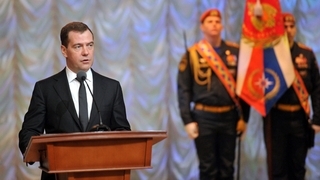Dmitry Medvedev attends a national assembly of the Emergencies Ministry and civil defence forces leadership in Krasnogorsk
30 january 2013
Until 1991, the Russian Federation basically lacked any coordinated state agency for addressing public protection issues or ways to ensure a more sustainable economic performance in war-time and peace-time on a comprehensive basis.
The joint Presidential State Committee for Civil Defence, Emergencies and Disaster Relief (GKChS) was established under Presidential Executive Order No 221 dated November 19, 1991 and was based at the RSFSR State Committee for Emergencies and the RSFSR Civil Defence Headquarters.
The incipient GKChS was formed as a national and inter-departmental state administration agency directly subordinated to the President. The GKChS coordinated the activities of territorial authorities and administrations, national ministries, departments, national inter-departmental corporations and associations involved in civil defence, emergency prevention and disaster relief.
On February 25-26, 1992, the Presidential State Committee for Civil Defence, Emergencies and Disaster Relief (GKChS) organised the first meeting of chairpersons from the emergency situations commissions in the regions, as well as deputy commanders of military districts for civil defence. GKChS Chairman Sergei Shoigu addressed the meeting and set forth Committee objectives. Deputy GKChS Chairmen,Viktor Vladimirov and Anatoly Tkachyov, outlined the structure and the main tasks of the national emergency prevention and response system, as well as specific guidelines for the reorganisation of the Russian civil defence system, its place and role within GKChS and within the national emergency prevention and response system.
Since 1992, Moscow hosted annual conferences for top officials of the national emergency prevention and response system. From 1996, these meetings were renamed the national assembly for top officials to sum up the results of the work of the Integrated Emergency Prevention and Response System (RSChS) and the implementation of civil defence projects.
The national assembly includes representatives from institutions of state authority, including representatives of the Presidential Executive Office, the Government Executive Office, as well as the Prime Minister or a Deputy Prime Minister. The assembly also includes representatives from both houses of the Federal Assembly; federal executive agencies (members of the Government Commission on Emergency Management and Fire Safety); leaders from the regions (chairpersons of commissions on emergency management and fire safety at regional administrations); members of the Public Council at the Ministry for Civil Defence, Emergencies and Disaster Relief; members of the Expert Council of the Ministry; top officials from the Central Administration of the Ministry and its territorial divisions; commanders of military units subordinated to the Central Administration of the Ministry and heads of ministerial organisations.
In the past, Prime Ministers Viktor Chernomyrdin, Yevgeny Primakov, Mikhail Kasyanov, Mikhail Fradkov and Vladimir Putin, as well as First Deputy Prime Minister Igor Shuvalov and Deputy Prime Ministers Oleg Soskovets, Alexander Zhukov and Sergei Naryshkin have attended the national assembly.
As a rule, the Minister for Civil Defence, Emergencies and Disaster Relief delivers the main report and reviews the operation of the RSChS and the implementation of civil defence efforts. He also sets objectives to improve the civil defence system and the RSChS performance.
Deputy Ministers, the heads of the Central Administration of the Ministry, the heads of regional centres of the Ministry, chairpersons of regional emergency management commissions and other convention participants report on the pertinent aspects of their work and on the implementation of civil defence efforts and projects.
State and departmental awards are always presented at the assembly.
Over the past few years, assembly participants have been involved in roundtable discussions. They exchange opinions, discuss important current issues and ways of accomplishing long-term objectives.
Exhibitions dealing with convention issues are timed to coincide with the national assembly. State-of-the-art prototype, upgraded and unique weapons, rescue and fire-fighting equipment and other technology, which are the result of research and development projects, are also shown to assembly participants, traditionally.

